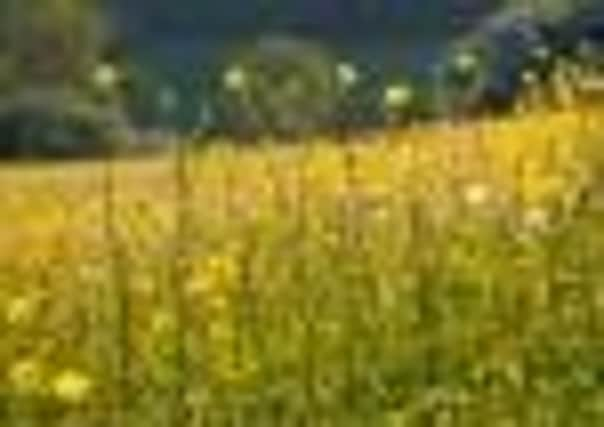Gardens: Join TV gardener Sarah Raven as she rediscovers the huge variety of wild flowers adorning our countryside


Sarah Raven is well known for her appearances on TV programmes like Gardeners’ World and for her garden at Perch Hill Farm in East Sussex, but it’s her passion for wild flowers that she’s now keen to share.
“All my life, I have been in love with wild flowers,” says Raven, explaining that in the 1970s, as a girl, she would go botanising with her father, John Raven, to see what they could find.
Advertisement
Hide AdAdvertisement
Hide Ad“We would see pasqueflowers on Therfield Heath in Hertfordshire, oxlips in Hayley Wood in Cambridgeshire, fritillaries in Magdalen Meadow, Oxford,” she says. On trips further afield they found alpine plants high on the hills of Argyll and sea-lavender on the salt marshes of the Norfolk coast. It’s clear she caught the wild flower bug at an early age, but after her father died when she was 17, the expeditions stopped. But years later she realised that the times she was happiest and most absorbed were when she went off on a walk just to see what wild flowers she might find.
The realisation spawned a new book project which saw Raven spending two years travelling with photographer Jonathan Buckley to more than a hundred sites around Britain and Ireland to research, catalogue and celebrate wild flowers. “Sometimes I would find 20 or 30 plants in one place, and Jonathan would then lie on his stomach for hours at a stretch photographing them,” says Raven. The book the pair have produced, Wild Flowers (£30, Bloomsbury), is far more than a botanical identification guide, combining dazzling photographs with colourful tales of individual plants and their wider habitats, opening our eyes to the diversity that’s on our doorstep.
When she set out to research the book, Raven had concerns that some of the most interesting flowers she remembered from her childhood might no longer be easy to find. “The facts and figures certainly made uncomfortable reading,” she says. “During the second half of the 20th century, we ploughed, drained and ‘improved’ – with fertilisers or herbicides – almost all of our ancient meadows; others were abandoned and grasslands became rank and dominated by bracken.” The UK Biodiversity Steering Group estimated that 97 per cent of lowland semi-natural grassland in England and Wales disappeared during the 50 years to 1984, and the surviving meadows are fragmented and often degraded. In fact, many semi-natural habitats were altered following the Second World War, as grants were introduced to encourage much-needed food production. From much-reduced chalk and limestone grasslands to drained wetlands, the odds seem to have been stacked against wild flowers.
Despite this, conservation work and grant funding to encourage habitat restoration has helped reverse the decline of wild flowers. “The flowers are more restricted in range than they once were, but far from extinct,” says Raven. “So, while there is no room for complacency, all is not lost.”
Her book groups wild flowers by habitat, profiling the species you are most likely to see in day-to-day life, as well as including a few rare species. The habitats she explores are wood; lane, wall and hedge; meadow; chalk down and limestone dale; arable and wasteland; water and wetlands; heath, moor and mountain; and coast. She’s also included plants that have escaped from cultivation as well as the true natives, figuring that people are just as likely to see these while out and about and want to know what they are.
Woodlands are where Raven directs us early in the year – from March there’s a chance to see such plants such as lesser celandine, ground-ivy, primrose and sweet violet. She takes us through the list of plants that appear before the deciduous tree canopy closes over in mid-May, listing wood anemone, bluebells and Lords-and-Ladies among the highlights. “If you are lucky, in open woodland with reasonable levels of light you will find some rarities in the late spring and summer wood,” she says.
“Fly Orchid and Greater Butterfly-orchid in May or June; Broad-leaved Helleborine a few weeks later. These stand like beacons, conspicuous from metres away, appearing in similar spots from one year to the next.”
Meadows are perhaps the most iconic spot for wild flowers, and Raven says that right up until the invention of the tractor, hay meadows were vital to the economy as a source of food for animals that were relied on for farm work. When that relationship was lost, meadows quickly followed suit. “The meadows we have left are very rare, places to revel in,” says Raven. “In these unimproved fields, the flowers are often thick on the ground and hugely varied. In May and June, the upper storey will be full of common sorrel, ribwort plantain and the crimson blobby heads of salad burnet. There will be lots of buttercups, too: bulbous, creeping and the tallest of all, meadow buttercup.” As well as being a guide to wild flowers, in many ways this book is a route map to some of the most special locations in Britain, be it the Lizard peninsula in Cornwall where thrift, chives and wild aspargus grow; or corn marigold and cornflower in the machair of the Outer Hebrides.
Advertisement
Hide AdAdvertisement
Hide AdIf there’s one thing this book makes you want to do, it’s go out exploring to get to know wild flowers better. And you might not have to go far, as Raven says: “Even if you are stuck in a traffic jam on the motorway, or sitting on a train staring out of the window, once you are tuned into this way of looking at the world, it is extraordinary what lovely things you will find right under your nose.”